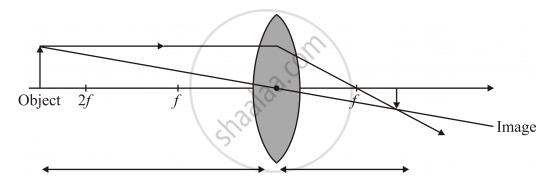Advertisements
Advertisements
Question
An object 5 cm high is held 25 cm away from a converging lens of focal length 10 cm.
(i) Draw the ray diagram and
(ii) Calculate the position and size of the image formed.
(iii) What is the nature of the image?
Solution

(i) `1/f=1/v-1/u=>1/v=1/f+1/u=>v=(uxxf)/(u+f);f=10 "cm",u=-25"cm"`
(ii) `v=((-25)xx10)/(10-25)=16.67`cm
`m=-v/u=-h_i/h_a`
`=>h_i=(vxxh_a)/u=(6.67xx5)/((-25))=-3.34`cm
(iii) Negative sign indicates that the image is real & inverted.
APPEARS IN
RELATED QUESTIONS
Draw ray diagrams to show the formation of three times magnified (a) real, and (b) virtual image of an object by a converging lens. Mark the positions of O, F and 2F in each diagram.
If the image formed by a lens for all positions of the object placed in front of it is always virtual, erect and diminished, state the type of the lens. Draw a ray diagram in support of your answer. If the numerical value of focal length of such a lens is 20 cm, find its power in new cartesian sign conventions.
State the sign convention to measure the distances for a lens.
All distances parallel to the principal axis are measured from the _______.
Write an Explanation.
Magnification
Linear magnification (m) produced by a concave lens is ______.
